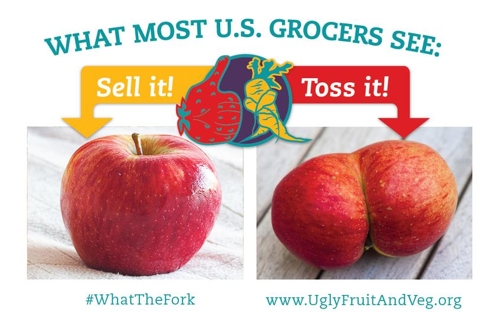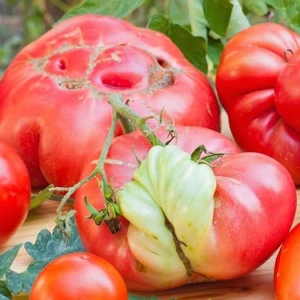I found a food news article this morning in which a whole bunch of experts agree with some of my best suggestions for saving on food. My heart warmed when I saw some of my less popular – but most useful – ideas vindicated…
 The ‘culling game’ accounts for the vast bulk of waste
The ‘culling game’ accounts for the vast bulk of waste
before food even gets to the supermarket shelf…
In the past, I’ve shared ideas more than once about how to eat better, pay less and just generally shop smarter at the grocery store. But some folks – especially people like my mom – have criticised me for suggesting what they consider risky bets on my and their health and safety. I’ve always said, I’m not counselling risky stuff at all.
Now, a collection of ‘experts’, is saying, ‘do what Maggie said, after all’.
What I said…
I said a lot of things, based on what I knew from my experience and culinary training. Like:
Ignore ‘Best Before’ dates
If the food looks okay and can be consumed or frozen before the actual expiry date, go for it. Supermarket ‘manager specials’ are all over the place. Especially on foods that cost the store more to stock-in originally. Lately, ultra-perishable foods like fresh meats have been getting labels that shout: ‘Enjoy Tonight!’. These are products very close to their Best Before dates but are perfectly fine to eat. They are, however, on the verge of staring to look tired on the shelf. Here’s the crunch:
Shoppers have trained to avoid ‘expired’ foods, meats especially, which could be harbouring serious diseases. But most still don’t know the difference between ‘Best Before’ and Expired’. On the other hand, supermarkets are fully aware of their responsibility to keep food known or likely to be dangerous off their shelves. If they actually sold ‘expired products, they’d liable to fines and worse under federal law. And if they sold stuff that was not wholesome and people got sick, their reputations would be ruined. My rule is, be guided by those who stand to lose the most in any given situation.
Use the time-proven ‘smell’ test
Getty Stewart, a Winnipeg-based home economist, says don’t be afraid to trust your nose. “Use the sniff test, especially for dairy. It will tell you when it’s ready to toss.”
Don’t be afraid to use ‘ugly’ food
Ugly food – those items that have blemishes or deformities coming in off the field or orchard – are almost always perfectly good to eat. They just have some spots you’ll want to pare our before using them. This is especially true of fresh produce Nobody worried about ‘ugly’ foods back in your grandmother’s day. That was because Grandma and everybody else in the neighbourhood grew most of what they needed in their own gardens and were used to seeing it.
Now it’s a very different story. Supermarkets and advertising (especially dvertising images in print and on TV) have educated consumers to expect all their tomatoes, potatoes, cucumbers, carrots, apples and oranges to be of uniform size and stage of ripeness. That means throwing out 2 or 3 imperfect ones for every one that’s found acceptable for sale. Or otherwise fails to meet the stringent ‘presentation’ requirements established by the food industry. This is the bulk of the food wasted by culling before it even leaves the farm gate.
Even more aging food is culled over its shelf life at the supermarket, becauase the markets don’t want their produce or meat to look less attractive than the competition’s. Field-to-store shelf waste is a major reason that foods cost so much by the time consumers get to even see them.
Don’t buy more food than you can use
Then, there’s the home waste factor. Folks throw out as much as 30 percent of the food they bring home from the store due to bad judgement when they buy. The food just goes bad in the fridge or on the shelf, because they buy more than they need. And they do that because they’re tempted by ‘2-for-1’ or other ‘discount’ deals designed by the stores to simply to move products before they start to look stale or worse in the store.
Don’t shop when you’re hungry
You’ll over-shop for sure. Not only will you be more likely to buy into fake ‘specials’, you’ll probably be more likely fall for point-of-sale deals or other impulse buying tricks. The vast majority us don’t have the money to spend on that stuff – without coming up short on the electricity or water bill, or something else critical.
Use your leftovers
Here’s a simple one: Just reuse or repurpose your leftovers, rather than automatically throwing them out. Better still, plan for leftovers when you buy foods and follow through – with stir-frys, casseroles, medleys, stews and soups, goulashes, and so on. Leftover produce even looks great in salsas, chopped salads, pizza and taco toppings etc. You are minimizing waste, too!
What we’re doing now is ‘just nuts’
The United Nations estimates that 17 per cent of global food production is wasted each year, rendering food waste both a social and environmental problem, too.
“We simultaneously have people that are still quite food insecure. They have trouble accessing food. There’s not enough food to go around,” Carleton University accounting professor Leanne Keddie says. “At the same time[,] anywhere from 30-60 per cent of our food is being wasted.”
It’s pretty simple accounting. What we’re doing now just doesn’t add up, literally.
My take
Shopping more thoughtfully, planning to use leftovers, and using the other techniques and strategies mentioned above are important things we can all do to help minimize waste and keep food prices down. But only if enough of us do them!
~ Maggie J.

